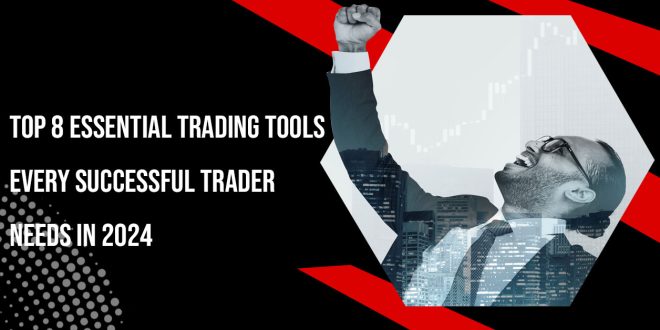The financial markets have evolved into a fast-paced environment where traders must make quick, strategic decisions that can result in significant gains or losses. Today’s markets operate at such a rapid rate that even a second can dramatically influence the outcome of a trade. To navigate this environment effectively, traders need a well-rounded toolkit of resources and technology to help improve their decision-making. Here, we’ll explore eight essential trading tools that are invaluable for success in 2024.
Modern trading technology has leveled the playing field, allowing more people than ever to participate. In the past, only individuals with exclusive connections and substantial resources could engage in trading. But with advanced technology, the barriers to entry have significantly lowered. Trading is now accessible to anyone with an internet connection and a bit of capital, thanks to innovations such as online trading platforms, algorithmic trading systems, and mobile apps. These advancements have democratized the trading landscape, allowing both beginners and experienced traders to seize market opportunities.
- Trading Platform: A trading platform is the software used to buy and sell assets, offering traders direct access to markets. With various platforms available, choosing one that aligns with your needs is essential. Consider the types of assets you want to trade, the features offered, and the platform’s fees. XtremeMarkets, for instance, provides a highly-rated forex trading platform known for its secure, efficient, and user-friendly interface. A good trading platform should offer real-time market data, intuitive charting tools, and smooth order execution, all of which are critical for executing trades quickly and accurately.
- Economic Calendar: An economic calendar tracks important dates for events and news releases that could impact financial markets, particularly currency exchange rates. By following these events, such as interest rate announcements, GDP releases, and inflation reports, traders can prepare for potential market movements. An economic calendar is a valuable tool for identifying trading opportunities and managing risks based on expected economic shifts. It allows traders to time their trades around these events, taking advantage of market volatility while being aware of potential risks.
- Technical Analysis Tools: Technical analysis tools help traders make predictions about future price movements by analyzing historical data, including price trends and trading volume. Key technical indicators, such as moving averages, Bollinger Bands, and Fibonacci retracements, reveal insights into market behavior. These tools allow traders to spot trends, patterns, and potential entry and exit points. Graphic charts visualize these indicators, making it easier for traders to interpret data and make informed decisions. Mastering technical analysis can offer a significant edge, as it helps identify favorable trading conditions and spot potential reversals in trends.
- Risk Management Tools: Effective risk management is crucial to protect your capital and limit potential losses. Tools such as stop-loss orders, take-profit orders, and trailing stops enable traders to manage risk proactively. A stop-loss order, for instance, automatically closes a trade if the asset’s price reaches a predetermined level, thus preventing further losses. Take-profit orders, on the other hand, ensure that your trades are closed once they reach a profitable level. Trailing stops add flexibility by adjusting your stop-loss level as an asset’s price moves in your favor. Using these tools strategically allows traders to safeguard gains and limit losses.
- Trading Journal:A trading journal is an often-overlooked yet invaluable tool for continuous improvement. By keeping a record of your trades, you gain insights into your strategies and decision-making patterns. Documenting each trade’s specifics—such as entry and exit points, position size, duration, and rationale—allows traders to identify what works and what doesn’t. Regularly reviewing a trading journal helps highlight strengths and weaknesses, fostering growth and enhancing trading performance. Traders can learn from past mistakes, refine their approach, and make more informed decisions moving forward.
- Stock Screener: A stock screener is a powerful tool that helps traders narrow down a vast selection of stocks to those that match specific criteria. By setting filters based on indicators like price, volume, or volatility, traders can focus on stocks with the potential for favorable returns. A well-designed stock screener can save time by eliminating irrelevant securities and allowing traders to concentrate on opportunities aligned with their strategies. For example, a trader looking for undervalued stocks might filter for low price-to-earnings ratios, while a momentum trader might seek stocks with high recent gains.
- News Feed: In the fast-moving world of trading, staying informed is essential. A reliable news feed keeps traders updated on developments in politics, the economy, and specific industries that impact market conditions. Even minor news events can trigger significant price changes, so having real-time access to news helps traders anticipate shifts and react promptly. A good news feed, whether integrated into a trading platform or a standalone service, provides timely updates on market movements, corporate earnings, and geopolitical events. Staying informed enables traders to make smarter decisions, capitalize on emerging opportunities, and manage risks effectively.
- Educational Resources:The financial markets are dynamic and complex, making continuous learning vital for any trader’s success. Educational resources, such as eBooks, articles, online courses, and webinars, provide valuable insights into market trends, trading strategies, and risk management. Many brokers, including XtremeMarkets, offer free educational content to help traders build their knowledge. By staying informed about the latest market trends and refining trading skills, traders can develop the expertise needed to make informed decisions in various market conditions. A commitment to ongoing education helps traders adapt to changes in the market and sharpen their competitive edge.
In summary: these eight essential tools form a robust foundation for any trader in 2024. From the right trading platform and economic calendar to risk management tools and educational resources, each of these components plays a crucial role in navigating the complex world of trading. Technology continues to advance, and with it, new tools will emerge, providing even greater access to market insights and decision-making capabilities. By leveraging these tools, traders can enhance their skills, manage risks effectively, and position themselves for success in the ever-evolving financial markets.
 Crypto trade Online Unlock the Future of Finance Today.
Crypto trade Online Unlock the Future of Finance Today.




